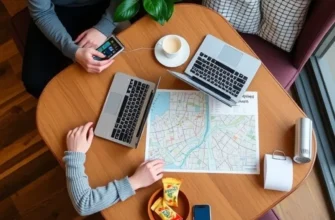Moving into a new place can feel like a mix of excitement and sheer panic. Between packing up your life into boxes and navigating the labyrinth of rental agreements, staying organized is key. Whether you’re a young professional embarking on a solo adventure, a couple starting a new chapter, or a family making a new home, having a robust moving supplies checklist can make all the difference. Take a deep breath; you can do this! We’ve compiled a practical, slightly humorous, and authoritative guide to ensure you’re fully equipped for the challenges of moving. So grab a cup of coffee (or tea) — it’s time to organize your packing strategy like a pro.
Gathering Your Moving Gear

When preparing for a move, the first step is to gather all the necessary supplies. Having the right materials on hand ensures a smoother, more organized process, allowing for safer packing and transport of your belongings. Here’s a comprehensive list to equip you like a moving expert.
Starting with the basics, you’ll need boxes of various sizes. Sturdy, corrugated cardboard boxes are essential for packing everything from books and kitchen items to clothing and decorative pieces. It’s wise to have a mix of small, medium, and large boxes to accommodate different items. Smaller boxes are ideal for heavier items like books, while larger boxes can be used for lighter, bulkier items such as linens or pillows.
Packing tape is another crucial item. Opt for durable, high-quality packing tape to securely seal your boxes. For added convenience, use a tape dispenser that makes applying tape faster and more efficient. It’s also beneficial to have a roll of stretch wrap or shrink wrap to bundle items together or protect furniture from scratches and dust.
Next, you’ll need protective materials to safeguard your fragile items. Stock up on bubble wrap, packing paper, and foam peanuts. These materials are excellent for wrapping delicate items or filling gaps in boxes to prevent movement. Consider using soft linens or clothing as an eco-friendly alternative to cushion certain items.
An often overlooked but invaluable tool is a labeling system. Use permanent markers to clearly label each box with its contents and the room it belongs to, making unpacking in your new home more organized. Color-coded labels or tapes can add an extra layer of clarity, immediately identifying which boxes belong to each room.
A furniture dolly can greatly reduce strain on moving day. This small but mighty tool helps transport several boxes or heavy furniture items with ease. Additionally, furniture sliders can be helpful for moving bulky items across floors without causing damage. Check out some tips on apartment organization to streamline your move further.
While packing, use scissors or a utility knife for cutting tape and breaking down boxes as needed. Keep a toolbox handy with screwdrivers, pliers, and a wrench for disassembling any furniture before packing.
Don’t forget the specialty items like mattress bags to protect your bedding or picture boxes for artwork and mirrors. Wardrobe boxes are excellent for transporting clothing without removing hangers, keeping apparel wrinkle-free.
Organizing your moving supplies into a dedicated area ensures everything you need is readily accessible when the packing begins. By gathering all necessary items and planning how to use them effectively, you’ll move through the packing process with ease, confidence, and expertise.
Packing Strategies That Work

Packing your belongings efficiently is crucial to ensuring a smooth moving experience. With all your supplies ready, let’s explore some strategies that can help keep your items organized and secure.
Start by categorizing your possessions. Group similar items together such as kitchenware, books, and clothing. This not only aids in organization but also makes unpacking easier. For instance, place books in smaller boxes to prevent them from becoming too heavy.
Labeling boxes is essential. Clearly mark each box with a description of its contents and which room it belongs to. Use a bold marker for visibility and consider color-coded labels for added clarity. This system reduces the chaos when boxes arrive at your new home.
When packing fragile items, use plenty of cushioning material. Wrap each fragile item in packing paper or bubble wrap. Place heavier items at the bottom of boxes and lighter ones on top. Fill any gaps in boxes with crumpled paper to prevent shifting during transit.
Storage solutions like baskets or clear bins can be invaluable, both for the move and in your new home. Learn more about utilizing baskets effectively for space management in this apartment organization baskets guide.
Now, let’s tackle the kitchen. Start by sorting gadgets and utensils you rarely use. Wrap glassware individually, and stack pots and pans with soft items between them. For larger appliances, read your user manual to ensure safe transportation.
Clothing can be packed directly from the closet using wardrobe boxes. Alternatively, use trash bags to group hanging clothes without removing them from hangers. Fold other clothing items neatly to maximize space within boxes or suitcases.
Electronics demand special attention. Pack each component separately, and label cables and accessories with their corresponding device. If possible, pack them in their original boxes. Always back up digital data as an extra precaution.
Finally, create an essentials box. This should include items you’ll need immediately upon arrival—like toiletries, a change of clothes, basic kitchenware, and important documents. Keep this box with you rather than with the moving company.
With these strategies, you can transform a potentially overwhelming process into an organized, efficient move. By thinking strategically, you ensure that your belongings remain safe and your new home is set up smoothly.
Final words
Armed with your moving supplies checklist and packing strategies, you’re now ready to tackle this transition! Remember, moving can be a whirlwind, but staying organized helps ease the chaos. So grab your checklist, keep the spirits high (and maybe a snack handy), and turn this potentially stressful situation into an adventure. The key is preparation, so check off each item and enjoy the journey to your new place!









